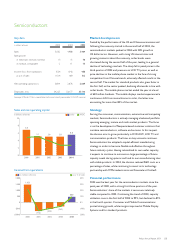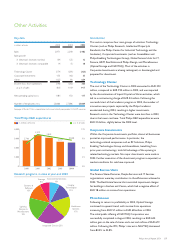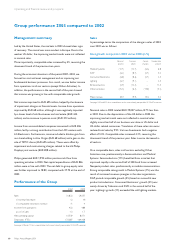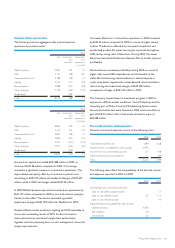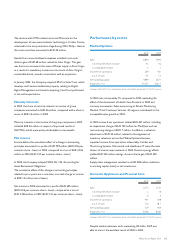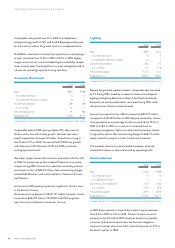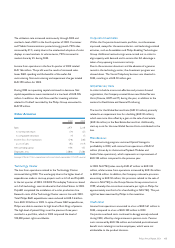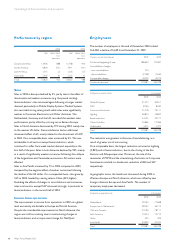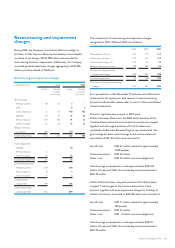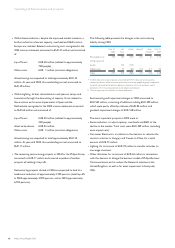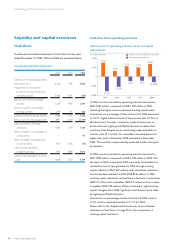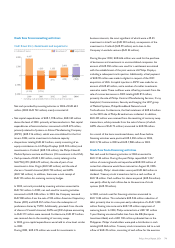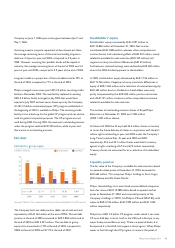Philips 2004 Annual Report Download - page 66
Download and view the complete annual report
Please find page 66 of the 2004 Philips annual report below. You can navigate through the pages in the report by either clicking on the pages listed below, or by using the keyword search tool below to find specific information within the annual report.
The utilization rate increased continuously through 2003 and
reached a level of 84% in the fourth quarter of 2003. Consumer
and Mobile Communications posted strong growth. MDS sales
increased by 31%, mainly due to the accelerated adoption of color
displays in new handsets. In volume terms, MDS increased its
market share by 4% during 2003.
Income from operations in the fourth quarter of 2003 totaled
EUR 166 million. The profit was the result of increased sales,
lower R&D spending and the benefits of the wafer-fab
restructuring. Net restructuring and impairment charges totaled
EUR 290 million for 2003.
During 2003 net operating capital continued to decrease. Net
capital expenditures were maintained at a low level of EUR 205
million. In addition, the cash flow used for investing activities
related to Crolles2 recorded by the Philips Group amounted to
EUR 99 million.
Other Activities
2002 2003
Sales 2,971 2,218
% nominal (decrease) (34) (25)
% comparable (decrease) (4) (5)
Income (loss) from operations (246) (263)
asa%ofsales (8.3) (11.9)
Net operating capital (181) 150
Employees (FTEs) 23,866 27,086
See pages 210 and 211 for a reconciliation to the most directly comparable US GAAP measures.
Technology Cluster
The loss from operations related to the Technology Cluster
increased during 2003. This was largely due to the higher level of
expenditures made in start-up projects such as LCoS and PolyLED.
In the last quarter of 2003, CINEOS Microdisplay Television, based
on LCoS technology, was introduced in the United States. In 2003,
PolyLED completed the installation of a color production line.
Research costs of the Technology Cluster were in line with 2002.
Total Philips R&D expenditures were reduced to EUR 2.6 billion
from EUR 3.0 billion in 2002. In spite of lower R&D expenditures,
Philips was able to maintain its high level of first filings of patents.
The high level of patent filings over the previous three years
resulted in a portfolio, which in 2003 surpassed the level of
100,000 patent rights worldwide.
Corporate Investments
Within the Corporate Investments portfolio, most businesses
improved, except for the semiconductor- and technology-related
activities, such as Assembléon and Philips Enabling Technologies
Group. Additional restructurings were carried out in order to
align capacity with demand and to ensure that full advantage is
taken of any upswing in economic activity.
Due to the economic downturn and the absence of a genuine
revival in the technology sector, the divestment program was
slowed down. The Vocon/Telephony business was divested in
2003, resulting in a EUR 20 million gain.
Global Service Units
In order to build a more cost-effective and process-focused
organization, the Company created three new Global Service
Units (Finance, HRM and IT) during the year, in addition to the
centers for Real Estate and General Purchasing.
The loss for the Global Service Units (EUR 23 million) primarily
related to an impairment loss for a building (EUR 30 million),
which was more than offset by a gain on the sale of real estate
(EUR 46 million) in the Real Estate Service Unit. Additionally,
start-up costs for the new Global Service Units contributed to the
loss.
Miscellaneous
The restructuring programs restored Optical Storage to
profitability in 2003, with income from operations of EUR 51
million (driven by its Automotive Playback Modules and
Audio/Video operations), which represents an improvement of
EUR 253 million compared to the previous year.
In 2003, NAVTEQ sales rose by EUR 67 million to EUR 242
million, while income from operations increased by EUR 45 million
to EUR 56 million. In addition, the Company released a provision
amounting to EUR 50 million; this provision related to the sale of
shares in NAVTEQ to the Oranje Nassau Groep consortium in
1999, whereby the consortium received a put right on Philips for
approximately one third of its shareholding in NAVTEQ. This put
right has been exercised by Philips in the meantime.
Unallocated
Income from operations amounted to a loss of EUR 561 million in
2003, compared to a loss of EUR 330 million in 2002.
Corporate overhead costs continued to be aggressively reduced
during 2003, offset by a large increase in pension costs. Pension
costs increased by EUR 256 million and included postretirement
benefit costs relating to inactive employees, which were not
attributable to the product divisions.
65Philips Annual Report 2004


